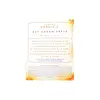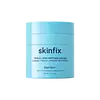What's inside
What's inside
 Key Ingredients
Key Ingredients

 Benefits
Benefits

 Concerns
Concerns

 Ingredients Side-by-side
Ingredients Side-by-side

Butyl Methoxydibenzoylmethane 3%
UV AbsorberEthylhexyl Methoxycinnamate 75%
UV AbsorberEthylhexyl Salicylate 4%
UV AbsorberBenzophenone-3 5%
UV AbsorberWater
Skin ConditioningSteareth-2
EmulsifyingHeptyl Undecylenate
EmollientEthylhexyl Triazone
UV AbsorberDimethicone
EmollientSteareth-21
CleansingOctyldodecanol
EmollientStearic Acid
CleansingC12-15 Alkyl Benzoate
AntimicrobialBis-Ethylhexyloxyphenol Methoxyphenyl Triazine
Skin ConditioningMethylene Bis-Benzotriazolyl Tetramethylbutylphenol
UV FilterPEG-30 Dipolyhydroxystearate
EmulsifyingRubus Chamaemorus Seed Extract
Skin ConditioningRubus Chamaemorus Seed Oil
Skin ConditioningButylene Glycol
HumectantPhenoxyethanol
PreservativeCetearyl Alcohol
EmollientTocopheryl Acetate
AntioxidantCaprylyl Glycol
EmollientPPG-15 Stearyl Ether
EmollientMica
Cosmetic ColorantCI 77891
Cosmetic ColorantCetearyl Dimethicone Crosspolymer
Panthenol
Skin ConditioningLecithin
EmollientDecyl Glucoside
CleansingAcrylates/C10-30 Alkyl Acrylate Crosspolymer
Emulsion StabilisingXanthan Gum
EmulsifyingMagnesium Ascorbyl Phosphate
AntioxidantSorbic Acid
PreservativePEG-8
HumectantDisodium EDTA
Sodium Hydroxide
BufferingTocopherol
AntioxidantSodium Lactate
BufferingLactic Acid
BufferingGlycerin
HumectantSerine
MaskingSorbitol
HumectantTea-Lactate
HumectantUrea
BufferingPropylene Glycol
HumectantAscorbyl Palmitate
AntioxidantSodium Chloride
MaskingChondrus Crispus
MaskingAscorbic Acid
AntioxidantCitric Acid
BufferingAllantoin
Skin ConditioningHippophae Rhamnoides Oil
EmollientRosmarinus Officinalis Leaf Extract
AntimicrobialHelianthus Annuus Seed Oil
EmollientCitral
PerfumingGeraniol
PerfumingHexyl Cinnamal
PerfumingLimonene
PerfumingLinalool
PerfumingButylphenyl Methylpropional
PerfumingParfum
MaskingButyl Methoxydibenzoylmethane 3%, Ethylhexyl Methoxycinnamate 75%, Ethylhexyl Salicylate 4%, Benzophenone-3 5%, Water, Steareth-2, Heptyl Undecylenate, Ethylhexyl Triazone, Dimethicone, Steareth-21, Octyldodecanol, Stearic Acid, C12-15 Alkyl Benzoate, Bis-Ethylhexyloxyphenol Methoxyphenyl Triazine, Methylene Bis-Benzotriazolyl Tetramethylbutylphenol, PEG-30 Dipolyhydroxystearate, Rubus Chamaemorus Seed Extract, Rubus Chamaemorus Seed Oil, Butylene Glycol, Phenoxyethanol, Cetearyl Alcohol, Tocopheryl Acetate, Caprylyl Glycol, PPG-15 Stearyl Ether, Mica, CI 77891, Cetearyl Dimethicone Crosspolymer, Panthenol, Lecithin, Decyl Glucoside, Acrylates/C10-30 Alkyl Acrylate Crosspolymer, Xanthan Gum, Magnesium Ascorbyl Phosphate, Sorbic Acid, PEG-8, Disodium EDTA, Sodium Hydroxide, Tocopherol, Sodium Lactate, Lactic Acid, Glycerin, Serine, Sorbitol, Tea-Lactate, Urea, Propylene Glycol, Ascorbyl Palmitate, Sodium Chloride, Chondrus Crispus, Ascorbic Acid, Citric Acid, Allantoin, Hippophae Rhamnoides Oil, Rosmarinus Officinalis Leaf Extract, Helianthus Annuus Seed Oil, Citral, Geraniol, Hexyl Cinnamal, Limonene, Linalool, Butylphenyl Methylpropional, Parfum
Water
Skin ConditioningCaprylic/Capric Triglyceride
MaskingGlycerin
HumectantButyrospermum Parkii Butter
Skin ConditioningOlus Oil
EmollientCetyl Lactate
EmollientPropanediol
SolventC12-16 Alcohols
EmollientCaprylyl Caprylate/Caprate
EmollientJojoba Oil/Macadamia Seed Oil Esters
Skin ConditioningGlyceryl Stearate Citrate
EmollientPalmitic Acid
EmollientHydrogenated Lecithin
EmulsifyingOryza Sativa Bran Extract
Skin ConditioningDilinoleic Acid/Propanediol Copolymer
EmollientSqualene
EmollientOphiopogon Japonicus Root Extract
Skin ConditioningXanthan Gum
EmulsifyingPhytosteryl Sunflowerseedate
Skin ConditioningGlycine Soja Extract
Skin ConditioningPentylene Glycol
Skin ConditioningCeramide NP
Skin ConditioningCeramide AP
Skin ConditioningCeramide EOP
Skin ConditioningHydrolyzed Rice Protein
Skin ConditioningChondrus Crispus Extract
Skin ConditioningHydrogenated Vegetable Glycerides
EmollientHelianthus Annuus Extract
EmollientSodium Hyaluronate
HumectantCitric Acid
BufferingPhytosteryl Macadamiate
Skin ConditioningTocopherol
AntioxidantRosmarinus Officinalis Leaf Extract
AntimicrobialAloe Barbadensis Leaf Juice
Skin ConditioningTrisodium Ethylenediamine Disuccinate
Phytosterols
Skin ConditioningSodium Lauroyl Lactylate
EmulsifyingGluconolactone
Skin ConditioningPhenethyl Alcohol
MaskingPhytosphingosine
Skin ConditioningCholesterol
EmollientCarbomer
Emulsion StabilisingPotassium Sorbate
PreservativeEthylhexylglycerin
Skin ConditioningSodium Benzoate
MaskingPhenoxyethanol
PreservativeWater, Caprylic/Capric Triglyceride, Glycerin, Butyrospermum Parkii Butter, Olus Oil, Cetyl Lactate, Propanediol, C12-16 Alcohols, Caprylyl Caprylate/Caprate, Jojoba Oil/Macadamia Seed Oil Esters, Glyceryl Stearate Citrate, Palmitic Acid, Hydrogenated Lecithin, Oryza Sativa Bran Extract, Dilinoleic Acid/Propanediol Copolymer, Squalene, Ophiopogon Japonicus Root Extract, Xanthan Gum, Phytosteryl Sunflowerseedate, Glycine Soja Extract, Pentylene Glycol, Ceramide NP, Ceramide AP, Ceramide EOP, Hydrolyzed Rice Protein, Chondrus Crispus Extract, Hydrogenated Vegetable Glycerides, Helianthus Annuus Extract, Sodium Hyaluronate, Citric Acid, Phytosteryl Macadamiate, Tocopherol, Rosmarinus Officinalis Leaf Extract, Aloe Barbadensis Leaf Juice, Trisodium Ethylenediamine Disuccinate, Phytosterols, Sodium Lauroyl Lactylate, Gluconolactone, Phenethyl Alcohol, Phytosphingosine, Cholesterol, Carbomer, Potassium Sorbate, Ethylhexylglycerin, Sodium Benzoate, Phenoxyethanol
Ingredients Explained
These ingredients are found in both products.
Ingredients higher up in an ingredient list are typically present in a larger amount.
Citric Acid is an alpha hydroxy acid (AHA) naturally found in citrus fruits like oranges, lemons, and limes.
Like other AHAs, citric acid can exfoliate skin by breaking down the bonds that hold dead skin cells together. This helps reveal smoother and brighter skin underneath.
However, this exfoliating effect only happens at high concentrations (20%) which can be hard to find in cosmetic products.
Due to this, citric acid is usually included in small amounts as a pH adjuster. This helps keep products slightly more acidic and compatible with skin's natural pH.
In skincare formulas, citric acid can:
While it can provide some skin benefits, research shows lactic acid and glycolic acid are generally more effective and less irritating exfoliants.
Most citric acid used in skincare today is made by fermenting sugars (usually from molasses). This synthetic version is identical to the natural citrus form but easier to stabilize and use in formulations.
Read more about some other popular AHA's here:
Learn more about Citric AcidGlycerin is already naturally found in your skin. It helps moisturize and protect your skin.
A study from 2016 found glycerin to be more effective as a humectant than AHAs and hyaluronic acid.
As a humectant, it helps the skin stay hydrated by pulling moisture to your skin. The low molecular weight of glycerin allows it to pull moisture into the deeper layers of your skin.
Hydrated skin improves your skin barrier; Your skin barrier helps protect against irritants and bacteria.
Glycerin has also been found to have antimicrobial and antiviral properties. Due to these properties, glycerin is often used in wound and burn treatments.
In cosmetics, glycerin is usually derived from plants such as soybean or palm. However, it can also be sourced from animals, such as tallow or animal fat.
This ingredient is organic, colorless, odorless, and non-toxic.
Glycerin is the name for this ingredient in American English. British English uses Glycerol/Glycerine.
Learn more about GlycerinPhenoxyethanol is a preservative that has germicide, antimicrobial, and aromatic properties. Studies show that phenoxyethanol can prevent microbial growth. By itself, it has a scent that is similar to that of a rose.
It's often used in formulations along with Caprylyl Glycol to preserve the shelf life of products.
Rosmarinus Officinalis Leaf Extract comes from rosemary. Rosemary is native to the Mediterranean.
While Rosmarinus Officinalis Leaf Oil can be volatile due to its fragrant properties, the fragrance components are usually removed in the leaf extract.
Rosemary Leaf Extract contains many antioxidants such as rosmarinic acid and caffeic acid. Rosemarinic acid, a compound found in rosemary leaf, has been found to help soothe skin conditions such as eczema and acne.
Learn more about Rosmarinus Officinalis Leaf ExtractTocopherol (also known as Vitamin E) is a common antioxidant used to help protect the skin from free-radicals and strengthen the skin barrier. It's also fat soluble - this means our skin is great at absorbing it.
Vitamin E also helps keep your natural skin lipids healthy. Your lipid skin barrier naturally consists of lipids, ceramides, and fatty acids. Vitamin E offers extra protection for your skin’s lipid barrier, keeping your skin healthy and nourished.
Another benefit is a bit of UV protection. Vitamin E helps reduce the damage caused by UVB rays. (It should not replace your sunscreen). Combining it with Vitamin C can decrease sunburned cells and hyperpigmentation after UV exposure.
You might have noticed Vitamin E + C often paired together. This is because it is great at stabilizing Vitamin C. Using the two together helps increase the effectiveness of both ingredients.
There are often claims that Vitamin E can reduce/prevent scarring, but these claims haven't been confirmed by scientific research.
Learn more about TocopherolWater. It's the most common cosmetic ingredient of all. You'll usually see it at the top of ingredient lists, meaning that it makes up the largest part of the product.
So why is it so popular? Water most often acts as a solvent - this means that it helps dissolve other ingredients into the formulation.
You'll also recognize water as that liquid we all need to stay alive. If you see this, drink a glass of water. Stay hydrated!
Learn more about WaterXanthan gum is used as a stabilizer and thickener within cosmetic products. It helps give products a sticky, thick feeling - preventing them from being too runny.
On the technical side of things, xanthan gum is a polysaccharide - a combination consisting of multiple sugar molecules bonded together.
Xanthan gum is a pretty common and great ingredient. It is a natural, non-toxic, non-irritating ingredient that is also commonly used in food products.
Learn more about Xanthan Gum